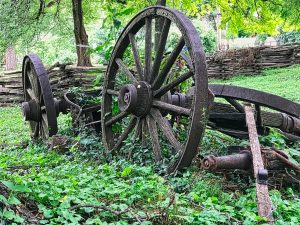The Shawnee Indian Mission in Fairway, Kansas served as a manual training school for children from the Shawnee, Delaware and other Native nations between 1839-1854 and continued as a school without manual training until 1862.
The Shawnee Mission also served as a supply point on the Santa Fe and Oregon Trails.
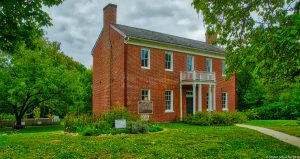
THE SHAWNEE NATION
The Missouri Shawnee were the first Native Americans removed to Kansas Territory, which was then set apart for emigrant tribes by the treaties of June 1825, with the Kanza and Osage.
By a treaty made at St. Louis, Missouri on November 7, 1825, the United States granted…
“to the Shawnee tribe of Indians within the State of Missouri, for themselves, and for those of the same nation now residing in Ohio who may hereafter emigrate to the west of the Mississippi, a tract of land equal to fifty miles square, situated west of the State of Missouri, and within the purchase lately made from the Osage.”
The relocation of the Shawnee to this land began in 1826. The 1.6 million acre reservation extended west for many miles, but the Shawnee chose to occupy only a small portion of the land. Few lived west of Lawrence, Kansas with the majority remaining in Wyandotte and Johnson counties in Kansas (both now metropolitan Kansas City).
By 1854, the U.S. government reduced the Kansas reservation to 160,000 acres and parceled out the rest of the land to settlers in 200 acre allotments.
During and after the Civil War, settlers antagonized the Shawnee and large numbers of Shawnee were ready to move elsewhere by the 1860s. Some remained on the Kansas reservation but most relocated to the Cherokee reservation in Oklahoma.
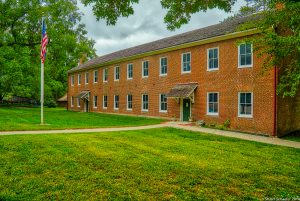
TREATMENT OF NATIVE CHILDREN
Children were immersed in European-American culture through forced changes. Methods included being forced to have European-American style haircuts, being forbidden to speak in their indigenous languages, and having real names replaced by European names.
The goals of the early education of Native children were to transform Native peoples and societies and eradicate Native self-government, self-determination, and self-education.
Children were often forcibly taken from their families and placed in boarding schools. “Boarding” schools were established by Christian missionaries of various denominations. The U.S. government paid religious orders to provide basic education to Native American children in order to assimilate them. Since the American culture of the times was based on rural agriculture, education of Native male children included manual training while Native female children were taught domestic skills.
THE SHAWNEE MISSION
A Methodist minister, Reverend Thomas Johnson, proposed to the Methodist Missionary Society that a centralized school be built to serve the children of many tribes. He chose a site where a branch of the Santa Fe Trail passed through Shawnee lands. The school opened at the current location in October 1839. Children of many tribes were sent to the school to learn basic academics, manual arts and agriculture. Some of the tribes included the Kanza (Kaw), Mjunsee, Delaware, Ottawa, Chippewa, Otoe, Osage, Cherokee, Peoria, Kickapoo, Potawatomi, Wea, Gros Ventres, Omaha and Wyandot.
At its height, the Shawnee Mission included more than 2,000 acres with 16 buildings, including an enrollment of nearly 200 Native boys and girls from the ages of 5-23.
Classes were held six hours each day except on Saturday and Sunday. On Saturday, teaching was limited to three hours. The boys worked in the shop or on the farm for five hours a day. The girls worked sewing, washing and cooking. The students went to bed at 8 pm. and rose at 4 a.m.
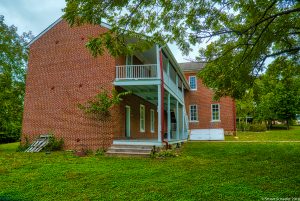
CENTER FOR TERRITORIAL GOVERNMENT
The Shawnee Mission also served as the second capital of the Kansas Territory. The capital was moved to the Mission on July 16, 1855, after pro-slavery delegates to the Territorial Legislature voted to leave the first capital located at Pawnee, Kansas. The first territorial legislature of Kansas met here and was called the “bogus” legislature because they began passing pro-slavery laws that led to the Bleeding Kansas revolt and violence. Kansas wanted to be a free state. During the Civil War, the Shawnee Mission served as a camp for Union soldiers.
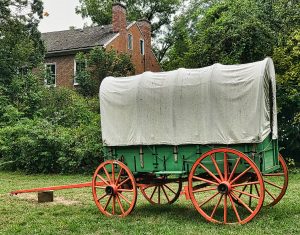
THE SHAWNEE MISSION TODAY
Three of the Mission’s original buildings still stand.
On the North side of the road is the building where the girls lived, and is where the school superintendent had his office. This building housed the territorial government. The building was originally 35′ X 135 ‘, but the building is now about 100 feet long.
There is a Mission cemetery on top of a hill, located a quarter mile southeast of the mission buildings. Reverend Johnson, the Mission’s founder, was bushwhacked and killed for being anti-slavery and is buried here.
The Shawnee Indian Mission is located in a beautiful suburb of Kansas City, Missouri called Fairway.
Shawnee Indian Mission, 3403 west 53rd Street, Fairway, Kansas 66205
913-262-0867
Public Hours: Wednesday through Saturday, 10 a.m.-5 p.m.
Admission: $5 for adult and $1 per child
